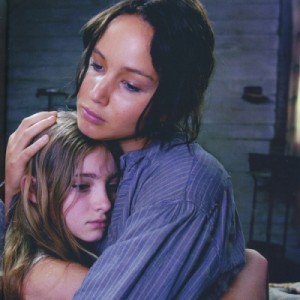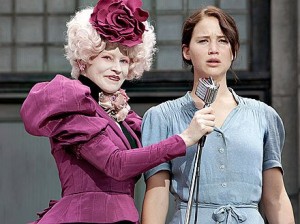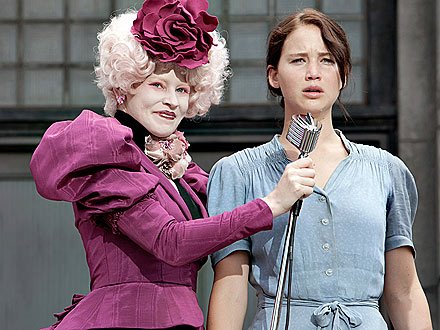Journey of a Strong Female Heroine: Katniss Everdeen
 Suzanne Collins has been widely praised for the success of The Hunger Games trilogy, including its story design, characterizations, pacing, writing craft, and allegorical and thematic content. Rightfully so, and there’s little to add to what’s already been said by so many others. The novel trilogy is a storytelling masterpiece, among the very best in the scifi/fantasy genre in the past decade or longer.
Suzanne Collins has been widely praised for the success of The Hunger Games trilogy, including its story design, characterizations, pacing, writing craft, and allegorical and thematic content. Rightfully so, and there’s little to add to what’s already been said by so many others. The novel trilogy is a storytelling masterpiece, among the very best in the scifi/fantasy genre in the past decade or longer.
What sets The Hunger Games apart from the rest of the field, though, is its lead character, Katniss Everdeen, and the skill with which Collins executes a novel trilogy centered around a young female lead. Where so many others have failed, or not even bothered to try, Collins not only creates a Strong Female Heroine, but also makes the story her Heroine’s Journey from impoverished nobody to national symbol. There are far too few stories of this kind in the genre – or anywhere else for that matter – even amid the prolific storytelling boom of recent years. For authors, screenwriters, and others struggling to figure out how to write better female characters and better female-centered stories, The Hunger Games has to be at the very top of the list to read, analyze, and learn from.
Throughout the novel trilogy, Katniss definitely fits the bill as a Strong Female Heroine. She is not an ordinary girl living an ordinary life, or even an ordinary girl forced into an extraordinary situation. Katniss is an extraordinary girl – who then becomes a hero by achieving success where most would fail. But she is not a Chosen One or ordained with a prophetic destiny; instead she is a girl who chooses to defy fate. What makes her special is not magical powers or divine sanction, but rather the willpower and emotional fortitude that give her the courage to endure through circumstances that would quickly break most people. At the same time, she is not a flawless person and she makes her share of mistakes, and this keeps her from becoming an idealized figure without resonance or relatability. Just like the rest of us, Katniss has no superpowers – but she has a bravery that most of us can only wish we possessed.
The core to Katniss’ success is her emotional strength. Even before the Reaping, she is the one holding her family together. She hunts with Gale, barters in the Hob, and risks the tesserae to keep food on the table. It is she, not her mother, who keeps their family functioning enough to ward off starvation.  Volunteering in Prim’s place, of course, is an act of courage that is so admirable precisely because that kind of self-sacrifice is so rare. Throughout her time in the Capitol and then in the Games, Katniss faces the full range of emotions that could easily have broken her – fear, anger, confusion, homesickness, helplessness, grief, and more. As happens to even the strongest person, at times these emotions dominate her thought and cause her to question whether she can really go on. In The Hunger Games and Catching Fire, her doubts are short-lived amid the frantic madness of the Games. Only in Mockingjay, after her severe burns and Prim’s death, does she experience an extended period of emotional incapacity, facilitated by medical sedation beyond her control. But no matter the situation, ultimately Katniss never breaks – she always finds a way to draw upon her inner reserves of courage and press onward to complete what she has to do, whether persevering to win the Games, escaping the Quarter Quell arena, or defeating Snow and the Capitol. Even at the end of the trilogy, when it would have been easy for Katniss to turn her back on the politics and return to District 12 to live out her days quietly, she yet again risks her own life to stop Coin’s new brand of tyranny. It is this inner fortitude that makes Katniss extraordinary, and gives her the strength to succeed in the face of challenges and grief that would break most people.
Volunteering in Prim’s place, of course, is an act of courage that is so admirable precisely because that kind of self-sacrifice is so rare. Throughout her time in the Capitol and then in the Games, Katniss faces the full range of emotions that could easily have broken her – fear, anger, confusion, homesickness, helplessness, grief, and more. As happens to even the strongest person, at times these emotions dominate her thought and cause her to question whether she can really go on. In The Hunger Games and Catching Fire, her doubts are short-lived amid the frantic madness of the Games. Only in Mockingjay, after her severe burns and Prim’s death, does she experience an extended period of emotional incapacity, facilitated by medical sedation beyond her control. But no matter the situation, ultimately Katniss never breaks – she always finds a way to draw upon her inner reserves of courage and press onward to complete what she has to do, whether persevering to win the Games, escaping the Quarter Quell arena, or defeating Snow and the Capitol. Even at the end of the trilogy, when it would have been easy for Katniss to turn her back on the politics and return to District 12 to live out her days quietly, she yet again risks her own life to stop Coin’s new brand of tyranny. It is this inner fortitude that makes Katniss extraordinary, and gives her the strength to succeed in the face of challenges and grief that would break most people.
Collins also does a masterful job of writing a strong character who is not only biologically a young woman, but also thoroughly female in her motivations and characterization. Katniss’ primary motivation throughout the series is protecting her family and friends. Prior to the Reaping, she strives to keep her family functional and fed; after volunteering, she wants to win so she can return home and continue that role. Unlike the Career tributes in The Hunger Games, or male protagonists in numerous other stories, Katniss is never motivated to win by goals like fame, glory, riches, or fulfilling a destiny. Her final bluff with the poison berries is as much an act of desperation to save Peeta as it is an act of defiance against the Gamemakers and the Capitol.
“This is actually a girl whose fierceness comes from a nurturing place, not a conquering place.”
~ executive producer Nina Jacobson, The Official Illustrated Movie Companion (p22)
This dominant thread of her characterization continues in Catching Fire, where her main objective in the tour of the Districts is to make sure Snow is satisfied with the display she and Peeta put on so that he does not retaliate against her loved ones, and her goal during the Quarter Quell Games is to keep herself and her allies alive long enough to escape. And in Mockingjay, Katniss does not fight in the rebellion or agree to be its public face because of any deeply held political principle or desire for personal power or individual triumph, but rather to create a nation where those she cares about, and the rest of Panem too, can return to living their lives without the threat of the tyranny or war.
Other aspects of Katniss’ characterization draw heavily on female qualities, too. In many stories, romance is treated as a distraction from the hero’s path; to many storytellers, a hero doesn’t have time for love.  Yet Collins understands that love and romance is an inextricable part of most people’s sense of self, and she deftly includes an undercurrent of romance within Katniss’ story. Unlike many stories with female protagonists, though, her feelings for Gale and Peeta do not dominate her thoughts, and they certainly do not define her goals in life or her own self-worth. On the other hand, just as Katniss is so often fueled by a motivation to keep her mother and Prim safe, her feelings for Gale and Peeta give her reasons to want to survive the Games, fight the Capitol, or end the war. Similarly, Collins rejects the male archetype of a lone hero facing his destiny, instead showing her heroine’s reliance on Team Katniss – her friends, allies, and collaborative success – to achieve victory. This dynamic has great resonance to the experience of many girls and women in the real world, as well.
Yet Collins understands that love and romance is an inextricable part of most people’s sense of self, and she deftly includes an undercurrent of romance within Katniss’ story. Unlike many stories with female protagonists, though, her feelings for Gale and Peeta do not dominate her thoughts, and they certainly do not define her goals in life or her own self-worth. On the other hand, just as Katniss is so often fueled by a motivation to keep her mother and Prim safe, her feelings for Gale and Peeta give her reasons to want to survive the Games, fight the Capitol, or end the war. Similarly, Collins rejects the male archetype of a lone hero facing his destiny, instead showing her heroine’s reliance on Team Katniss – her friends, allies, and collaborative success – to achieve victory. This dynamic has great resonance to the experience of many girls and women in the real world, as well.
Finally, in a genre where morally gray characters and antiheroes are the dominant fad lately, Katniss is refreshingly good and heroic in her motivations and deeds. She kills because she has to, not because she wants to or enjoys it, and she regrets the necessity of it. She fights not for personal glory or selfish gain, but to protect or help others. She repeatedly risks her life not for the prospect of reward, but because it is the only chance to save those she cares about. But selflessness alone does not make a hero – there also must be a cause or quest, a fight and sacrifice for something greater than oneself. In The Hunger Games, Katniss takes only her first step along that path; if her only act of defiance against the Capitol had been the berries bluff to save Peeta, her character would not be nearly as memorable. It is in Catching Fire and Mockingjay where Katniss truly transitions from selfless protector to epic heroine, as she comes to realize that surviving the Games was not enough, and that the only way she will ever find peace for herself and her loved ones is to topple the tyranny of the Capitol once and for all.  Although Gale and some of the leadership of District 13 and the rebellion may make morally questionable decisions in pursuit of winning that war, throughout her progression from the Girl on Fire to the Mockingjay, Katniss remains true to who she is, including her inner goodness. War is nasty business, but Katniss ends the trilogy a heroine, just as she started it.
Although Gale and some of the leadership of District 13 and the rebellion may make morally questionable decisions in pursuit of winning that war, throughout her progression from the Girl on Fire to the Mockingjay, Katniss remains true to who she is, including her inner goodness. War is nasty business, but Katniss ends the trilogy a heroine, just as she started it.
The Hunger Games novel trilogy also stands out as one of the few well-known stories to feature a Heroine’s Journey, meeting all the elements of the definitional concepts we described last week. The story is epic in scope, reaching far beyond Katniss’ initial victory in the 74th Hunger Games to her role as a symbol of the uprising against the Capitol and her final heroic triumph over both Snow and Coin. The story also has mythic qualities, as well, including elements of ancient legends like Theseus and Spartacus in addition to elements more frequently associated with modern myths, such as the hero rejecting the expectations of others. The Hunger Games is also a coming of age tale, portraying the maturation of a small-town girl into an heroic young woman. And it is, of course, Katniss’ tale – she is the sole point-of-view narrator of the novel trilogy, and her character development and story arc is the primary focus of the trilogy. Katniss may not get her happily ever after, but she does live to see the fruits of her victory come to pass, even if the remainder of her life will always have a bittersweet sense of loss, pain, and healing.
Collins’ story design for Katniss’ Heroine’s Journey in some ways mirrors the shape of one of the most famous contemporary stories framed on Joseph Campbell’s Hero’s Journey, Luke Skywalker’s path in the Star Wars original trilogy films. The first movie, now known as A New Hope, contains essentially a fully formed Hero’s Journey – beginning, middle, and end – within its plot. When George Lucas had the financial success to guarantee two more films in Luke’s story, though, he drew heavily upon the middle and end segments of the Hero’s Journey for much of Luke’s character development in The Empire Strikes Back and Return of the Jedi, so that the Original Trilogy as a whole also serves to take Luke through a full Hero’s Journey. In a similar manner, the first book of The Hunger Games moves Katniss through nearly a full Heroine’s Journey character arc as her story moves from before the Reaping to her return to District 12 after her victory.  Unlike Lucas, though, Collins had a signed contract for a trilogy from the start, and so she had the authorial security to allow the story design to deliberately truncate the ending elements of the Heroine’s Journey arc in the first book, knowing that Catching Fire and Mockingjay could continue Katniss’ transformation into a heroine and play out a full Heroine’s Journey over the span of the three novels.
Unlike Lucas, though, Collins had a signed contract for a trilogy from the start, and so she had the authorial security to allow the story design to deliberately truncate the ending elements of the Heroine’s Journey arc in the first book, knowing that Catching Fire and Mockingjay could continue Katniss’ transformation into a heroine and play out a full Heroine’s Journey over the span of the three novels.
At the same time, Collins’ development of Katniss’ Heroine’s Journey in the novel trilogy is a great example of the ways in which a well-constructed female-centered Heroine’s Journey will have some similarities to, and some differences from, the male-centered Campbellian Hero’s Journey. For example, the beginning stages of Katniss’ journey in The Hunger Games novel are highly analogous to Campbell’s model: she begins by refusing the “call to adventure,” insisting she cannot run away with Gale because she has to stay and care for her mother and Prim; she then is forced into her adventure by circumstances, when she feels compelled to volunteer in Prim’s place at the Reaping; she acquires a mentor, Haymitch, who trains her for her heroic quest, the Games; and she undergoes both a figurative and literal metamorphosis in the Capitol, proving her worth as the girl who earned an 11 score in the Training Center and experiencing her fashion reinvention into multiple iterations of the Girl on Fire by Cinna and the prep team. On the other hand, significant aspects of the middle portion of her Heroine’s Journey – running across the plotlines of all three novels – diverge from Campbell’s model, particularly in the way Katniss uses teamwork and collaboration to succeed and her reliance on friends and allies as sources of strength rather then as temptations away from her quest, as well as her refusal to submit to the role or destiny others seek to choose for her.
There is a great deal more to say about how Katniss’ journey in The Hunger Games trilogy can serve as a well-crafted example of a Heroine’s Journey for a Strong Female Heroine, including comparisons with other female characters’ journeys and contrasts with Campbell’s model. We will definitely be returning to our analysis of her character arc in subsequent posts of the Heroine’s Journey blog series.
In the meantime, be sure not to miss Katniss’ big screen debut as a strong female heroine in the opening act of her Heroine’s Journey, in theaters everywhere March 23.
B.J. Priester is editor of FANgirl Blog and contributes reviews and posts on a range of topics. A longtime Star Wars fandom collaborator with Tricia, he is also editing her upcoming novel Wynde. He is a law professor in Florida and a proud geek dad.
- BJ Priester Talks The Acolyte Episode 6 on Who’s the Bossk? - July 7, 2024
- Dave Filoni Talks Writing AHSOKA and Guiding the Future of Star Wars Storytelling - June 21, 2024
- Lessons in Franchise Management – MCU: The Reign of Marvel Studios - January 14, 2024










Pingback:Girls on Film: Katniss Everdeen and the Problem with Hero Worship | Video Zone
Pingback:Girls on Film: Katniss Everdeen and the Problem with Hero Worship
Pingback:Hodge Podge: Aside the Fourth Wall in the Arena, the Stage, and a Hotel in Chelsea « …and this is what comes next
Pingback:Why Do We Write The Things We Do? « fangirlblog.com
Pingback:The Hunger Games (October 2013 discussion) | Bossard Booklovers